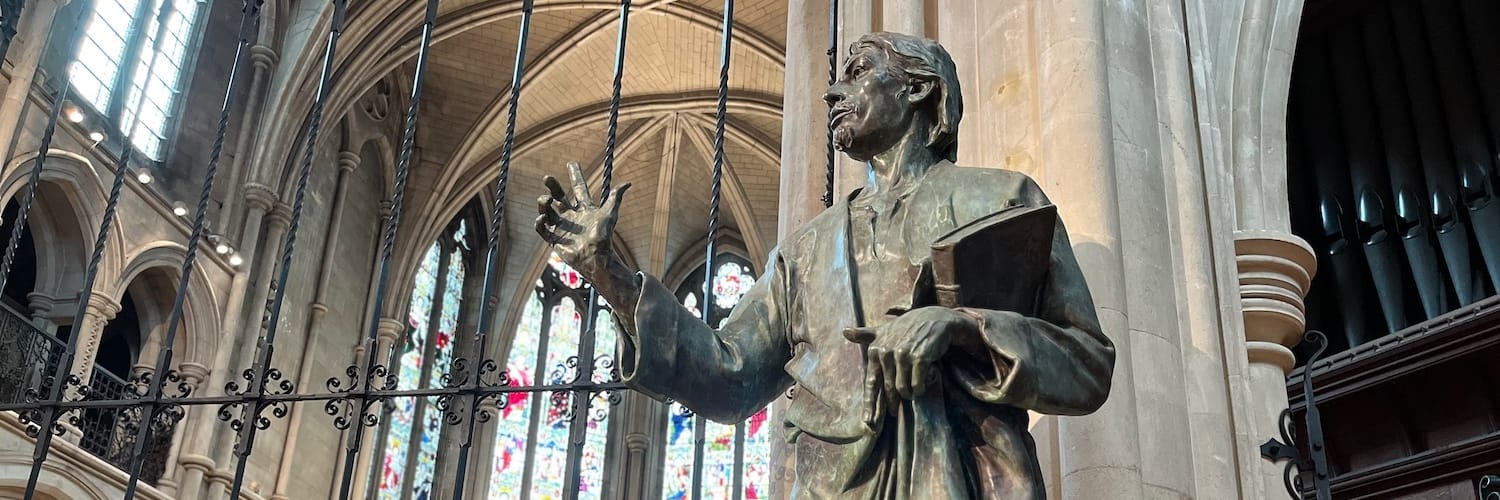
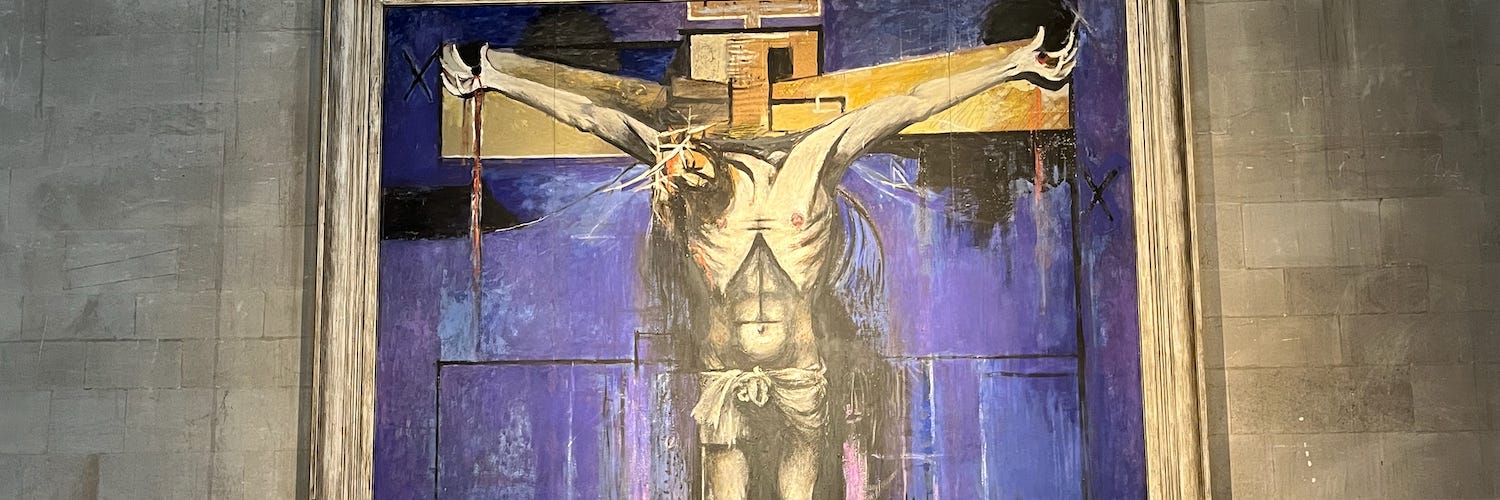


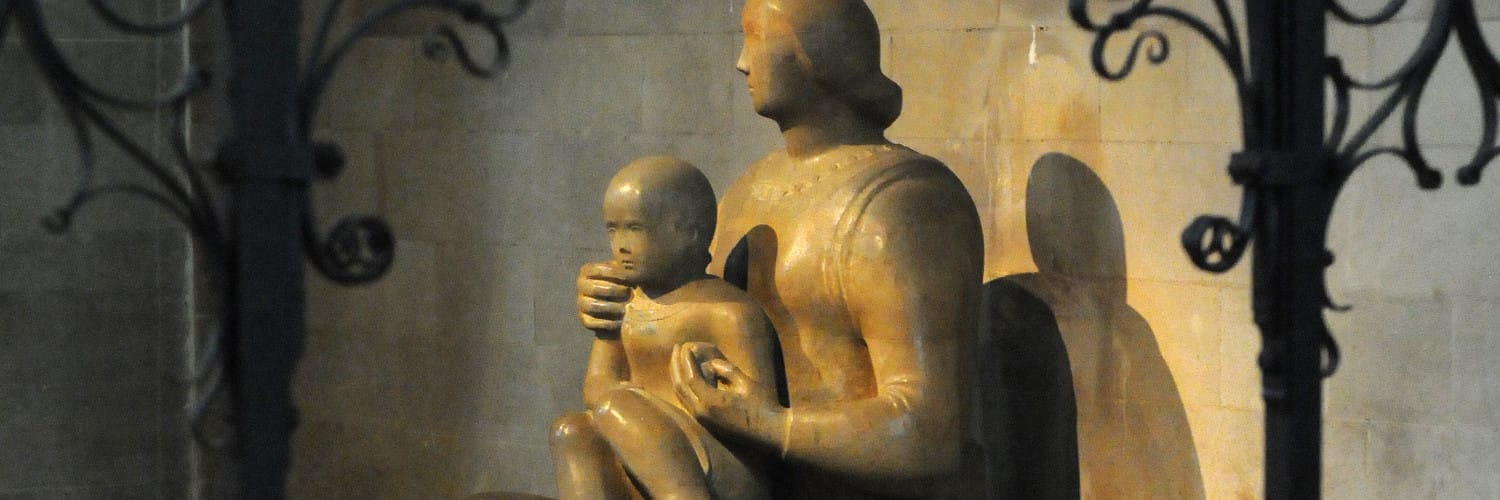


Art & History - The Memorial Chapel
Remembering Kingsley’s Fallen Heroes
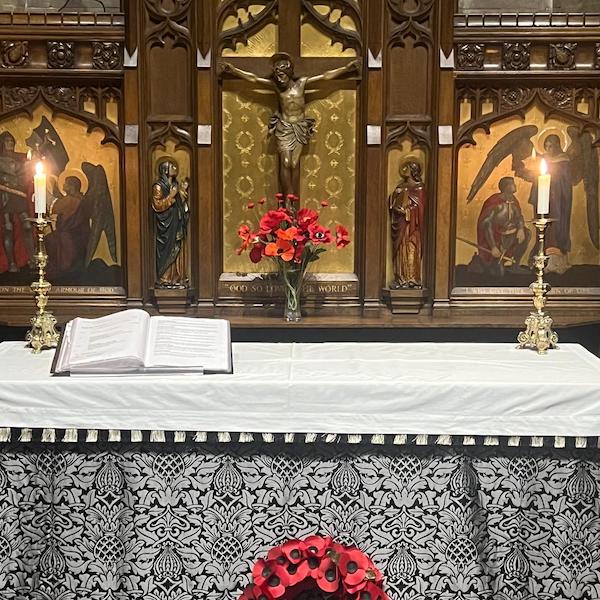
The Memorial Chapel was dedicated in 1921 to remember the servicemen of the parish who gave their lives in the Great War, later incorporating the names of those who have died in later conflict. The church is hoping to fully research every one of the men named on its Memorial Chapel Roll of Honour so they can be properly remembered for future generations.
World War I
Researchers Martin and Lindsey Stone carried out painstaking research to build case studies of every one of the 126 Great War dead in time for the
100th anniversary of the Armistice in 2018. Their efforts caused a frenzy of media activity, including live BBC TV coverage from the church.
At the Remembrance Sunday service on 10 November 2019, we were able to identify for the first time each of the servicemen commemorated in our Memorial
Chapel and honour them using their Christian name and age and when they died. Three new individuals have been added, with some outstanding details
remaining. As a direct result of this work, we were joined at the Remembrance service by descendants of several of the servicemen.
J Atkinson = John, Pte, East Surrey Regt, Aged 33 (link provided by M Wills).
A G Barnfield, Alfred, Pte, Nptons, Aged 21.
R Baseley = Ralph Bazeley, LCpl, Seaforth Highlanders, Aged 24.
N S G Beale = Norman, 2Lt, Nptons, Aged 21.
W E Bellamy = William, Cpl, MGC(Inf) Regt, Aged 21.
A A Billingham = Arthur, Sjt, Suffolk Regt, Aged 30.
R B Bishop = Rowland, Capt, MiD, Nptons, Aged 26 (Brother Gerald also Capt).
C Blundell = Charles, Pte, Beds Regt, Aged 25.
A B Boston = Albert (as baptised), attested as Arthur, Pte, Nptons, A19.
P J Boyes = Percy, Sapper, RE, Aged 31.
A Britten = Alfred, Pte, Royal Fusiliers Regt, Aged 37.
A C Byles = Andrew, Pte, RAMC, Aged 25.
S B Carvell = Sydney, AB, RN, Aged 20.
F Caswell = Frank, Rfn, Rifle Brigade, Aged 25.
A Chatfield = Alfred, Pte, Queens Own Hussars Regt, Aged 21.
E A Cheshire = Alfred, Pte, Suffolk Regt, Aged 21.
D K Cooper = Donald, LCpl and 2Lt, Hants Regt and Nptons, Aged 22.
R C W Dale = Russell, LCpl, Grenadier Guards, Aged 27.
A T Day = Arthur, Pte, Nptons, Aged 24.
G Denton = George, Pte, Northumberland Fusiliers Regt, Aged 32.
A F Dunkley = Albert, Sjt, Nptons, Aged 21.
C A Eyden = Clarence, Cpl, Railway Transport, RE, Aged 27.
P J Falkner = Percy, Pte, Nptons, Aged 21.
G A Faulkner = George, Pte, Lincs plus Notts&Derby Regt, Aged 18.
W Faulkner= William, Gnr, Royal Garrison Artillery, Aged 31.
H E Fitness = Harold, Gnr, Honourable Artillery Co, Aged 31.
W E Fitzhugh = Walter (baptised), attested as Ernest, Gnr, RGA, A 24.
A J Garner = Arthur, Pioneer, RE, Aged 25.
E Goddard = Ernest, Pte, Nptons, Aged 21.
C E Goodman = Charles, Pte, Ox&Bucks LI Regt, Aged 24.
W Graves = William, Pte, Nptons, Aged 30.
H T Gurnham = Harry (Henry), Sjt, E.Surrey Regt, A 23 (bro of WG Gurnham).
W G Gurnham = William, Pte, Beds Regt, Aged 25 (bro of HT Gurnham above).
H H Hall = Harry, 2Lt, Cambs Regt and Notts&Derby Regt, Aged 31. --------|
P F Hall = Percy, Pte, Royal Fusiliers Regt, Aged 19. -- (3 of 5 brothers fell) --|
W D Hall = William, Pte, Hampshire Regt, Aged 28. ---------------------|
H Harris = Harry, Pte, Nptons and Royal Fusiliers Regt, Aged 24.
J D Haviland = John, Lt, Royal Fusiliers Regt, Aged Aged 34.
F A Heap = Frank, Pte, Nptons, Aged 18 (brother of FW Heap below).
F W Heap = Frederick, 2Lt, DLI Regt, Aged 31 (brother of FA Heap above).
A J Herbert = Albert, Pte, Nptons, Aged 20.
H T Holmes = Harry, Cpl, Nptons, Aged 22.
C B Hornby = Cyril, 2Lt, Kings Shropshire LI Regt, Aged 24.
P Howlett = Percy, Pte, Nptons, Aged 21.
A J Hughes = Archibald, Pte, Beds Regt, Aged 19.
F H Hundley = Francis, Sjt, Nptons and Labour Corps, Aged 25.
E J Howes = Edward, Pte, Royal Fusiliers Regt, Aged 42.
F Jeffs = Frank, Pte, East Kent (The Buffs) Regt, Aged 30.
A F Johnson = Alfred, Pte, Kings Shropshire LI Regt, Aged 20.
J F Johnson = James, A/Sjt, Nptons, Aged 22.
H Jones = Henry, Sjt, Royal Garrison Artillery, Aged 36 (brother of Tom below).
T Jones = Tom, Gnr, Royal Garrison Artillery, Aged 34 (brother of Henry above).
C Kendall = Charles, Staff Sjt, Army Ordnance Corps, Aged 51.
H E C Kendall = Herbert, Lance Sjt, Nptons, Aged 23 (son of C Kendall above).
J W King = John, Royal Marine LI RN (Div), Pte, Plymouth Bn, Aged 20.
W G Labrum = William, Pte, Royal Fusiliers Regt, Aged 19.
A E Langton = Albert, Pte, Royal Welsh Fusiliers Regt, Aged 29.
A E Law = Arthur, Pte, Nptons, Aged 19.
C Letts = Cecil, LCpl, Nptons, Aged 21.
L W Lilford = Lorenzo, Pte, Nptons, Aged 21.
A E Lovell = Alfred, Pte, Nptons plus Yorks. Regt, Aged 20.
A H Lowe = Arthur, Sapper, RE, Aged 33.
E Mace = Ernest, 2Lt previously Cpl, Nptons, Aged 23.
A E Mackley = Albert, Pte, Nptons, Aged 25.
H Marlow = Harry, Pte, Middlesex Regt, Aged 34.
B Mason = Bertram, AB, RN(Div), Anson Bn, Aged 19.
R McDowell = Richard, Pte, Queens Royal West Surrey Regt, Aged 38.
C Miller = Christopher, Pte, Nptons, Aged 27.
F Miller = Francis, Pte, Queens Royal West Surrey Regt, Aged 28.
B D Mills = Bertie, Cpl, Beds Regt, Aged 21.
A C Moss – Alaric, Pte, Royal Navy and 85th Bn Canadian Inf, Aged 19.
J H Moss = Jesse, Pte, Suffolk Regt, Aged 27 (brother of Alaric above).
W H Moules = William, Cpl, Nptons, Aged 35.
G E Nash = George, Pte, Suffolk Regt, Aged 28.
G Newcombe = George, Pte, Nptons, Aged 24.
W A Osborne = William Osborn, Pte, Middlesex Regt, Aged 28 (see notes).
R W S Packer = Reginald, Lt QM, previously Cpl, RF & MGC, Aged 27.
J G Page = Joseph, LS, RN, Aged 24.
W Page = William, Pte, Royal Scots, Aged 27.
C S Palmer = Charles, Gnr, RGA, Aged 32.
A W Payne = Alfred, Pte, Nptons, Aged 23.
W R Peach = William, Pte, Cheshire Regt, Aged 18.
B W Pitt = Bevan, 2Lt, previously Pte, RFC, Aged 19.
S J Redley = Sidney, Pte, 1st Life Guards, Aged 23 (used alias Henry).
W J Richardson = William, Cpl, Norfolk Regt, Aged 41.
F Robinson = Frank, Pte, Nptons, Aged 21.
R Robinson = Ralph, Flight Sub-Lt, RN serving with 206 Sqn RAF, A 19.
W T Robinson = William, L/Stoker, RN, Aged 24.
A Rodwell = Arthur, Cpl, Nptons, age 20.
A Ross = Alexander, Sjt, Royal Fusiliers, Aged 23 (brother of R Ross below).
R Ross = Ralph, Pte, Manchester Regt, Aged 19 (brother of A Ross above).
B G Rowley = Bertram, S/Lt (Obs), RNAS, Aged 31.
H S Sargent = Herbert, Pte, Nptons, Aged 25.
L W Saunders = Leonard, Sapper, RE, Aged 29.
J W Shaw = John, 2Lt, MC, previously CSM, KRRC, A 38.
W Spring = Walter, Sjt, Nptons, Aged 25.
C Smith = Charles, Pte, Northumberland Fusiliers, Aged 19.
F J Smith = Frederick, Stoker 1st Class, RN, Aged 25.
W H Smith = William, Boy Telegraphist, RN, Aged 17.
W R L Smith = William, Sapper, RE, Aged 19.
A Stevenson = Alfred, Pte, DCLI Regt, Aged 34.
W Sturgess = William, Pte, Queens Royal West Surrey Regt, Aged 18.
A G Swann = Alfred Swan MM, A/Sjt, Nptons and Royal Eng., Aged 26.
H J Tarry = Herbert, Pte, 1st Res Cav. Regt and 12th Lancers, Aged 22.
W Tate = Walter, Pte, Nptons, Aged 29.
R P Taylor = Ralph, 2Lt, Nptons, Aged 20.
A B Tebbutt = Arthur, Lt, previously Sjt, Nptons and Norfolk Regt, A 24.
C F Tolliday = Charles, LCpl, London (London Scottish) Regt, Aged 26.
G H Tompkins = George, Cpl, Ox & Bucks LI Regt, Aged 35.
J Tong = James, Pte, 15th Bn Canadian Inf, Aged 30.
S G Treadgold = Sydney, Pte, Nptons, Aged 19.
W E Ward = Walter (attested), Ernest (baptised), Pte, Nptons, Aged 23.
A E W Wardle = Albert EW Wardell, A/Mech 2nd Cl, RAF, Aged 20.
W H Waters = William, A/Bdr, RA, Aged 19.
J W Watson = James, Pte, London Regt, Aged 20.
T G West = Thomas, Leading Seaman, RN, Aged 28.
R W Westley = Ralph, Trooper, 1st Life Guards, Aged 21.
F Wills = Fred, Pte, Suffolk Regt, Aged 17.
P J White = Percy, Stoker 1st Class, RN, Aged 23.
W T White = William, Pte, Norfolk Regt, Aged 37.
R E J Walden = Rand, 2Lt, Lancs Fusilers, Regt, Aged 35.
F P Wiggins = Frank, CQSM, Nptons, age 34.
G Wright = George, Sjt, Nptons, Aged 32.
C J Wykes = Charles, Pte, Loyal N. Lancs Regt, Aged 33.
A W Yorke = Arthur, Pte, Npton Yeomanry, Aged 22.
Also, that those men not listed on the screens although remembered within the parish who fell during the First World War, include:
Pte Joseph Allen [3/10711 2Bn Nptons, Aged 42],
AB Alfred Bodily [R/3895 RNVR and RND Drake Bn, Aged 25],
L/Cpl Cyril Webster [2161 Npton Yeo and then Labour Corps, Aged 32].
V0.95, dated 27th February 2025.
The couple then turned their attention to gathering information about the WW2 names. The Second World War analysis required a different process and generated records with a very different flavour to those of the First War.
World War II
The Second War analysis revealed another level of the extreme violence of total war, and has been well described as somehow more personal. Again,
all the St Matthew's names identified have been of men, while nationally CWGC records for the period contain a great number of civilians and
servicemen male and female. The other amazing anomaly is that of the 42 brave men who fell in the Second War, three were De-Havilland Mosquito
pilots. Two of these Mosquito pilots fell on operations, one was lost in June 1945 after a distinguished operational career and his transfer
'to rest' as an instructor on an Operational Training Unit (OTU). These are two of the few anomalies from a statistical point of view, as the
42 men listed cover almost every theatre of war and every mode of service that you could read about in a short tome on the war itself.
As examples, one third of the men listed served in the Royal Air Force. One of these was a Spitfire pilot who lost his life on what is now
Battle of Britain Day. Three of the aircrew were on Coastal Command operations, three were Mosquito pilots, one of these a Flt Lieut with the
Distinguished Flying Cross and Bar, five were Bomber aircrew. Twenty-three of the men served in the British Army across the different regiments
of infantry, artillery, and service support. Three of the men were Royal Navy including a Royal Marine. Two men were prisoners of the Japanese.
Another escaped from the Japanese in his Catalina aircraft with his crew mates, and was reported rescued in an article in a local newspaper,
when in fact a few days after his escape he was tragically killed in an air reconnaissance mission off Ceylon. Many of the men were married.
At least one had a daughter whom he would never meet. Whatever their situation, they were all mothers' sons.
We have men listed on the St Matthew's World War Two screens that are buried in Northampton, North Africa, France, Holland, Germany, Italy and
Formosa (now Taiwan). We have men listed who died in the Battle of Britain, the evacuation of France in 1940, Singapore, Ceylon, Burma, D-Day
operations, Alamein and the advances through Sicily and Italy. The screens include those who are listed as having no known graves and are
represented on their service memorials, for example Runnymede for the Royal Air Force, Chatham and Plymouth for the Royal Navy. The remains of
several of those who were originally thought to have no known graves or who were otherwise not appropriately remembered or buried were, subsequent
to the action in which they were lost, recovered and re-interred - process entitled then as 'Graves Concentration'. This is a feature in the records
of several of our Second War fallen. Another feature of our Second War fallen is that the majority were killed in the latter years of war.
We can deduce and support several matters from this for a wider understanding of the period, the men and their families. For example, Field Marshall
Montgomery may well have been correct to be considered cautious with his manpower even late in the war. His reticence to support multi-national
operations, namely with the Americans at the expense of British and Commonwealth lives, may have been well founded. We can also deduce that our
lists of men are representative of numbers and losses across the three services as a whole, as well as the geographical areas in which this war was
principally fought. And perhaps finally a lesson that most of us would already realise, that volunteering or being nominated as aircrew in either
war was indeed a dangerous game.
E L Armer = Ernest, Pte, 5th Bn Nptons, Aged 27.
C G Baldwin = Clifford, Pte, Royal Army Ordnance Corps, Aged 33.
C R Barber = Cyril, Gnr, 397 Bty 121 LAA Regt, Royal Artillery, Aged 33.
C T Barrett = Cyril, Dvr, 1678 Artillery Platoon RASC, Aged 40.
J Barringer = Jack, L.Tel., HMLCH 185 RN, Aged 29 (brother George also fell).
J A Beer = Jack, W/O Pilot, 464 Sqdn, RAFVR, Aged 22.
F T Bennett = Frederick, Tpr, B Sqdn 44th Tank Rgt, RAC, Aged 27.
W Ceybird = Wilson, F/O, DFM, 143 Sqdn RAFVR, Aged 24.
D S Cleaver = Donald, Cpl, 15 Sqdn, RAFVR, Aged 36.
W G Clifton = Wilfred, Gnr, 51 Field Regt Royal Artillery, Aged 22.
S J Dodd = Sidney, L/Bdr, 139 Field Regt Royal Artillery, Aged 22.
P H Douglas = Phillip, Officer Cadet, Royal Engineers, Aged 23.
A E Earl = Arthur, LAC, RAFVR, Aged 26.
T W Farmer = Thomas, Sgt Nav, 550 Sqdn, RAFVR, Aged 32.
G E Flinn = George, Stwd, HMS Hurworth RN, Aged 32.
A D Garley = Albert, Sgt, Royal Army Medical Corps, Aged 25.
S A Greenfield = Silas, Pte, 1 Base Supply Depot RASC, Aged 20.
P A Harrison = Percy, Sgt Pilot, 29 Elementary FTS, RAF, Aged 22.
A Hillson = Arnold, Spr, 54 Field Coy Royal Engineers, Aged 21.
A J Hussey = Albert, L/Cpl, 8th Bn Royal Fusiliers, Aged 23.
M Jackson = William M., Lt, 2nd Northants Yeomanry RAC, Aged 33.
J S Jones = John, Gnr, 22 Field Regt Royal Artillery, Aged 20.
T Jones = Tom, Gnr, 443 Bty, 64th Searchlight, 1/6th Essex, Aged 26
(his father also Tom Jones, Gnr, Royal Garrison Artillery fell 25 Yrs previously, see St Matthews WW1 list)
S Knight = Sidney, Sgt W.Op.& Air Gunner, 12 Sqdn, RAFVR, Aged 22.
G A Langley = Gerald, P/O Pilot, 41 Sqdn, RAFVR, Aged 24.
R W Law = Reginald, Cpl, 1st Bn Nptons, Aged 25.
K A Laxton = Keith, P/O, 107 Sqdn RAF, Aged 21.
J D Marshall = John, Pte, Seaforth Highlanders, Aged 27.
J J Reeve = John, Pte, 4th Bn Kings Shropshire Light Infantry, Aged 31.
A E Roberts = Albert, LCpl, Royal Army Service Corps, Aged 25.
F Rogers = Frank, Sgt, Yorks Hussars. Royal Armoured Corps, Aged 38.
D J Rushton = Dennis, Sgt, 218 Sqdn, RAFVR, Aged 20.
N Russell = Noel, FlLt, DFC & Bar, Instructor RAFVR, Aged 24.
R A Sabell = Ronald, Sgt Air Gunner, 106 Sqdn, RAF, Aged 24.
R Smith = Reginald, Mne, No41 Cdo Royal Marines, Aged 20.
R Smith = Reginald Thomas, Spr, Royal Engineers, Aged 25.
H A Tyrrell = Herbert, Lt, 80Lt AA Regt Royal Artillery, Aged 28.
N Vials, believed to be Gordon Nigel, regt affiliation unknown, Aged 19.
S Vials = Stephen, Sgt, 221 Sqdn, RAFVR, Aged 26 (brother of Gordon Nigel).
J W Wykes believed to be JW Wilkes, James, Spr, Royal Engs, Aged 21.
Flt Sgt Clifford Keith Morton [15740, Royal Air Force, 619 Sqdn, Aged 22]
The authors welcome any additional information including updates or corrections, which should be directed to the Parish Office for forwarding to the authors. Authors and Copyright at www.stonesmilitaryhistories.co.uk (2017-2025)
V0.95, dated 27th February 2025.
Further information
Any further information, particularly from members of the families, and where medals, photographs, postcards and letters could be scanned for reference,
would add considerably to the academic rigour of the efforts to identify and further honour the men concerned. Progressing the work on the Second War
fallen has led us back to families with links to the First War fallen, adding clarity to the work achieved so far. Mr Stone said:
If you can help, please contact Martin Stone via the Parish Office.
Information Quick Links
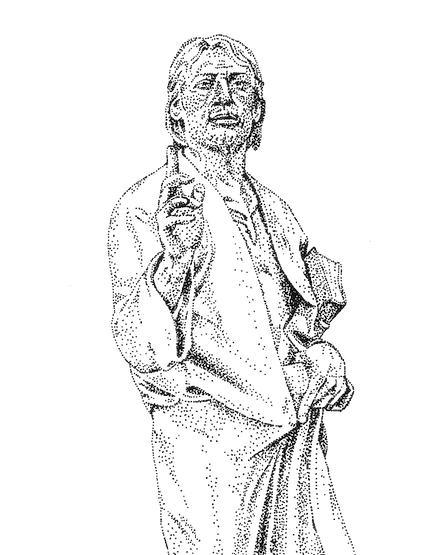
Join our Mailing List
To receive our email newsletter regarding the latest news and upcoming events at St Matthew's, kindly provide us with your name and email address below. By opting in and subscribing, you'll stay informed about our community, special services, insightful articles, and other valuable content.
Connect with us
Please show your support by following and subscribing to our church and choir social media channels, where you can find inspiring content, updates on our events and services, live streamed services, and uplifting messages.







